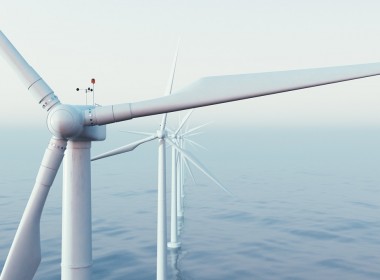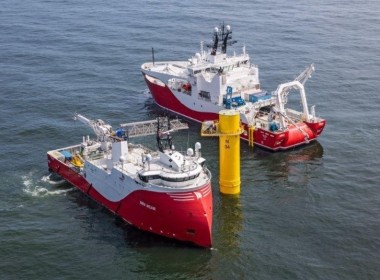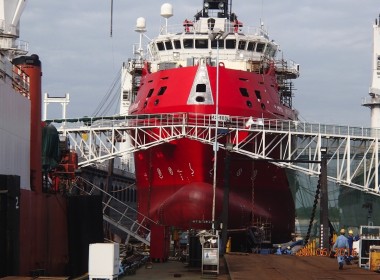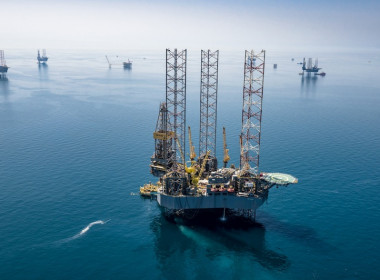COLUMN | Looking to the future: Petrobras newbuilds; James Fisher; Saudi Arabia’s NEOM plans; TotalEnergies and Sapura; wind bust timing [Offshore Accounts]

“Brazil is the country of the future,” goes the cliché that the Austrian writer Stefan Zweig declared in 1941 as the opening line of his book Brazil, Land of the Future.
Zweig wrote in exile there, and a year later, he and his wife deliberately killed themselves with a drug overdose. Brazilians then began joking that their nation was “the land of the future, and always will be.”
This week we see how Brazil really is the country of the future in one respect, and we look at several problems and opportunities associated with different futures.
Petrobras: company of future newbuild PSVs
Last year, we realised that Tidewater’s efforts to push large platform supply vessel (PSV) day rates to US$40,000 per day would provoke a backlash – both from charterers attempting to find ways to avoid paying top dollar and from speculators seeking to offer newbuilds that are very economically attractive once rates stick at those price levels.
Now appropriately, Brazil’s state oil company Petrobras has shown up that being held hostage by the world’s largest PSV owner is not mandatory for oil companies.
Petrobras has a vision for the future: newbuild Brazilian-flag PSVs built at local shipyards contracted against long-term charters to be delivered in 2028. The company has issued a tender for 12 DP2 PSVs with diesel-electric battery hybrid propulsion, 1,000 square metres of clear deck space, with 1,800 tonnes of deck cargo, and a total cargo capacity of 5,200 DWT.
Ethanol as a future fuel in Brazil
The vessels are required to have Clean Design (Tier III) and to be adaptable for dual fuel operation with ethanol or methanol.
Ethanol is widely available in Brazil and is used extensively in land transport. The Financial Times has highlighted how the “vast majority of cars sold today in the nation run on fuel flex technology that allows them to use either petrol or biofuel, which is almost 40 per cent cheaper and cuts carbon emissions by about 75 per cent.”
Note that Petrobras is not looking at liquefied natural gas (LNG) or ammonia for what will be the largest newbuild programme in a decade.
Brazilian shipyards are famous for their high costs, due to the country’s customs regime and labour laws, whilst Brazil’s high taxes and social fund requirements make Brazilian crew far more expensive than those of most other markets, with the exception of Norway and Australia. Already in recent tenders, Petrobras has been paying over US$50,000 per day for PSVs, drawing in tonnage from as far afield as Indonesia. By 2028, Tidewater’s fleet will have an average age of over 15 years if it continues with its current policy of raising day rates and performing share buybacks.
Coming on the back of Total’s decision to buy 75 per cent of the Tungsten Explorer deepwater drilling rig in return for a ten-year charter, this Petrobras tender shows that energy companies with predictable long-term needs may increasingly turn to newbuilds to reduce their cost of capital. Why pay for aged vessels at high prices to fund Tidewater’s stock buybacks, when you can pay lower prices based on the long-term cost of capital for brand new vessels?
Petrobras’ tender signals a new future for the industry where newbuilds are back as an option. Brazil – with its target to increase production to five million barrels of oil per day – is going to be the land of the future when it comes to PSV newbuildings.
Brunei Shell Petroleum has also issued a newbuild tender for various categories of vessels. There will be more.
James Fisher and Sons: Is there a future?
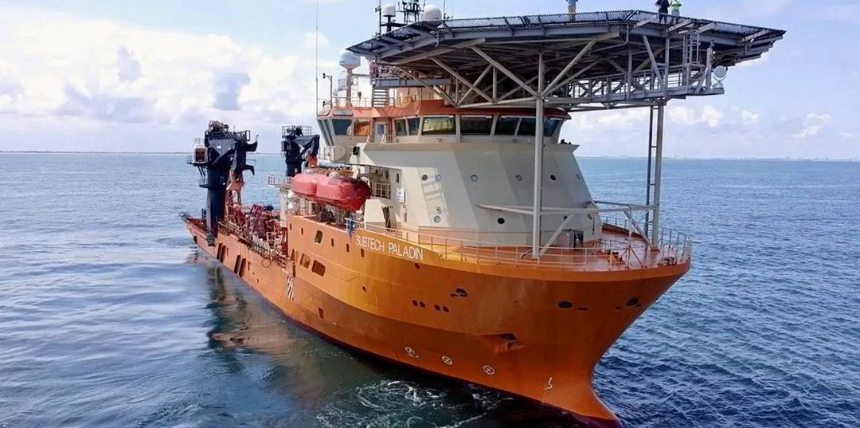
In early 2020, when the UK’s James Fisher and Sons had a market capitalisation of over US$1.3 billion, we asked whether there was “something fishy at James Fisher.” None of the company’s numbers made any sense to us, and the metronome-like consistency with which the company reported earnings growth across all four of its divisions every year for years, whilst bingeing on random acquisitions and adding good will to the balance sheet, seemed inexplicable – suspicious, even.
Since we wrote our piece, the wheels have completely fallen off the company. Write-down after write-down has followed, the business has had three CEOs in five years, and earnings have collapsed. But don’t worry, it now has a gender inclusivity target on page 26 of the presentation!
The company sold its two subsea and diving vessels Subtech Paladin and Swordfish for cents on the dollar at the bottom of the market in 2021 and 2022. It has now announced that it will be closing the Subtech Europe office, incurring a loss of around US$4 million.
90 per cent value destruction for shareholders
Today, James Fisher and Sons is worth approximately US$150 million. The charitable trust that is the company’s largest shareholder has seen the value of its investment seriously damaged – and yes, we did point out that the trustees were extremely ill-advised to have doubled down in 2021 and bought more shares in the business, as the torrent of bad news showed no sign of abating.
Since then, the shares have fallen another 66 per cent and now stand at 276 pence, back where they were in 2004. The trustees should perhaps focus on the fact that their primary responsibility is to the charity, and to its ability to fund its charitable causes in Barrow-in-Furness, not to supporting the share price of the marine company that is their largest investment.
The latest set of annual results (here) announced two weeks ago show the extent of the wipe-out. As usual, James Fisher’s embattled management focused on “underlying operating earnings” of £29.6 million (US$37 million). Unfortunately, these underlying operating earnings exclude the small matter of the company’s finance charges, the cost of refinancing the business, taxes, and the cost of restructuring its disastrously ill-managed businesses.
Again, we counsel readers to ignore such obfuscation and focus on the bigger picture and the actual reported numbers.
On a fully inclusive basis, taking into account all these pesky details (because, you know, tax is actually a cost, as are interest and refinancing charges), James Fisher and Sons lost £18.6 million (US$23.3 million).
Ouch.
Asset-light because barely any assets remain
Now the company has announced that it will be selling off RMS Pumptools for £90 million (US112.5 million) in an effort to stabilise the balance sheet, which had over US$180 million of debt at the end of 2023. RMS makes drilling intervention tools and artificial lift equipment for oil and gas companies. James Fisher has also sold off its nuclear business.
Looking ahead, James Fisher says that it wants to be “a services company operating in the Blue Economy, leveraging market and customer synergies” with a claim of becoming “asset-light with a focus on pooling assets, people and resources.” Given that there are barely any assets left, this seems appropriate.
Our bet is that the remainder of the business will be bought by a private equity company and leveraged up again. Its bubble curtain business will be attractive to green investors like Cyan Renewables and other sustainable investors – bubbles curtains are deployed to shield the marine environment from the noise of windfarm piling.
The sad tale of James Fisher is a reminder of the line from the HBO miniseries Chernobyl about the Soviet mismanagement that led to the destruction of the eponymous nuclear plant: “Every lie we tell incurs a debt to the truth. Sooner or later that debt is paid.”
Saudi Arabia: a much shorter future for NEOM
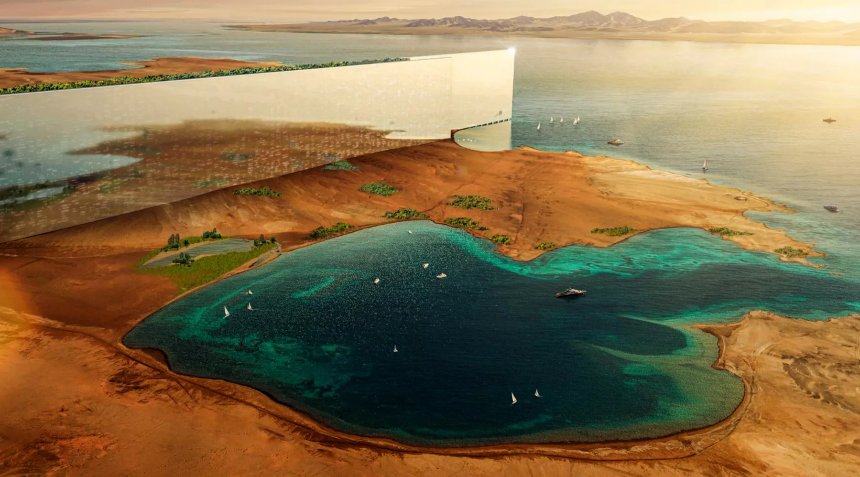
So, it is not just Saudi Arabia’s rig count that is being cut, with about a quarter of the 92 jackup drilling rigs working for state oil company Saudi Aramco being suspended in the coming months, as the country reduces its total oil production capacity target by a million barrels per day, as we reported in February.
Along with the twenty-something rigs coming offhire, at least forty or fifty offshore support vessels (OSVs) will also be released into the regional market. National champion Rawabi with its fleet of 150 vessels is likely to be in the front line of this contraction in drilling activity.
Now the centre-piece property development of Crown Prince Mohammed bin Salman, NEOM, a US$1.5 trillion (with a “T”) project in the north-west of the country is being scaled back, at least in the short term, Bloomberg reports. The original plan for NEOM’s main city, known as The Line, called for a vast, air-conditioned glass and steel city to be built in a corridor stretching 170 kilometres through the bare desert from the Red Sea coast.
Saudi officials have confirmed that they expect that just 2.4 kilometres of The Line will be completed by 2030, and that rather than housing 1.5 million people, The Line will have about 300,000 residents in 2030. The offshore marina on Sindalah Island is due to open this year and the ski resort of Trojena has to be completed by 2029 in order to host that year’s Asian Winter Games (We are sure Saudia Arabia’s Winter Games hosting opportunity must have been awarded in a transparent and non-corrupt manner, like the FIFA Football World Cup, which the kingdom has also won the right to host in 2034.).
Yes, you did read that correctly. Saudi Arabia is building an outdoor ski resort that will be the most southerly in the northern hemisphere outside India. Elevations stretch from 1,600 to 2,600 metres, which is not high by French standards, let alone when compared to resorts in the Rockies and the Andes. Yesterday, Reuters highlighted that NEOM was raising US$2.6 billion from local Saudi banks. This is a drop in the ocean compared to NEOM’s capital requirements.
It is hard to avoid the conclusion that NEOM’s reduced scale and diminished vision is tied to Saudi Arabia’s oil dependency.
The country finds itself still dependent on oil and is trying to walk a tightrope. If oil prices rise too high, OPEC and Saudi Arabia are vulnerable to a wave of new capacity coming online, with everyone from shale oil producers in the US to exciting new deepwater discoveries in Namibia, Guyana, and Suriname able to develop big new projects at US$80 per barrel prices. If prices fall too far, however, Saudi Arabia faces a budget crisis.
First came the floods that devastated Dubai two weeks ago and saw Porsches bobbing down the highway, now a 98 per cent reduction in the length of The Line, the Crown Prince’s most ambitious project.
The climate is certainly changing in the Gulf.
Getting a future: Sapura saved by TotalEnergies
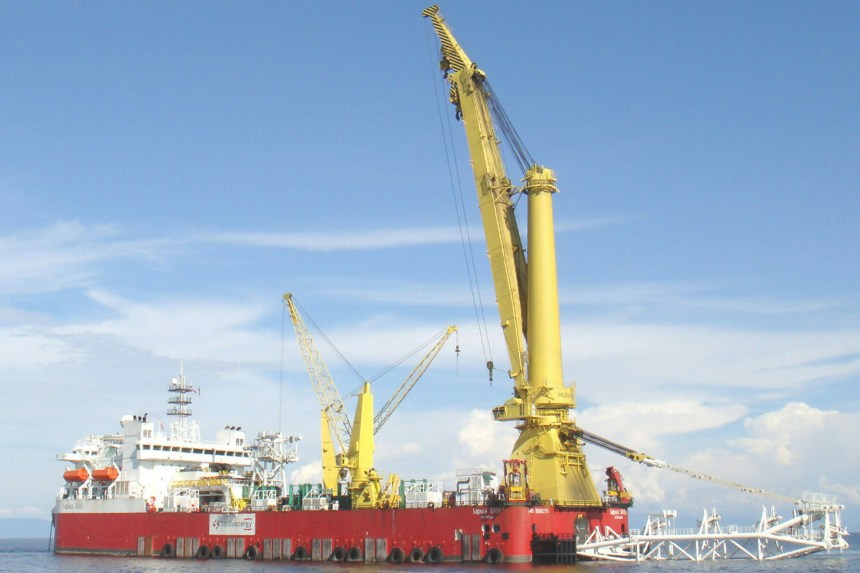
When we looked at troubled Malaysian contractor Sapura Energy in 2022, we used the lyric of Aussie singer Natalie Imbruglia as the headline: “nothing’s right I’m torn”.
Nothing was right for Sapura. The company was labouring under the burden of US$2 billion of net debt and was under a court programme to protect it from its creditors. Sapura embarked on scrapping three of its surplus and laid-up tender assist drilling rigs for US$8.2 million and selling some of its construction assets, including the jewel in the crown, its 2008-built pipe-laying and crane vessel Sapura 3000, which was sold for US$71.5 million to Abu Dhabi Ports Group later in 2022.
In February, we reported that Sapura had been hit with a €50 million (US$54 million) arbitration claim from a Taiwanese wind farm operator, aggrieved at its alleged poor performance in the installation of the Yunlin offshore wind farm.
Hopes that a “White Knight” might emerge to buy the company have not materialised, but last week, the company achieved a milestone in its Reset plan, announced in 2023. TotalEnergies has thrown a lifeline to Sapura.
TotalEnergies will buy Sapura’s 50 per cent shareholding in the SapuraOMV joint venture for US$705 million, giving it full control of the company. TotalEnergies had previously paid OMV US$910 million to the other half of SapuraOMV. It is not clear why Sapura got so much less for its half of the exact same company, but a desperate and indebted seller rarely makes a strong negotiator.
Both transactions will close later this year, and we can expect SapuraOMV to be rebranded as TotalEnergies. SapuraOMV owns 40 per cent of Malaysian offshore Block SK 408 and operates the Jerun gas field project there, with production expected to commence later this year. It also holds a 30 per cent stake in and operatorship over Malaysian Block SK 310 nearby.
In 2023 SapuraOMV, produced around 7,000 barrels of condensate per day, and some 500 million cubic feet (14.1 million cubic metres) of gas per day, which it piped to Petronas’ LNG plant in Bintulu in Sarawak. The company also owns a portfolio of exploration acreage elsewhere in Malaysia and internationally in Australia, New Zealand, and Mexico.
530 million reasons to be happy
Sapura will receive US$530 million in cash from TotalEnergies, and the French company will also take over a US$175 million loan that Sapura had incurred to OMV when it could not contribute to a refinancing of SapuraOMV.
The sale of its stake in SapuraOMV should lead to a net gain for Sapura of around MYR793 million (US$155 million).
The deal is important for two reasons. Firstly, it saves Sapura. When it closes, the company should be able to complete a restructuring by paying off some debt with the cash and encouraging its other creditors to swap more debt for equity. The new Sapura will be smaller and more focused than before, but it should survive as a Malaysian national champion in offshore construction.
Secondly, the deal highlights TotalEnergies’ renewed focus on gas, coming as it does on the heels of an announcement that it will start work on what it claims is the lowest carbon intensity LNG plant on the world, Marsa LNG in Oman.
Sapura Energy has a future and TotalEnergies is increasingly highlighting its future is in gas as much as oil.
(When) Will there be a future wind bust?
One of the questions we want to explore for a future column is when/if there will be a wind bust.
If we are writing about the future of offshore, the biggest unanswered question (apart from the future fuels debate) is whether the wind industry will follow the volatility and cyclicality of offshore oil and gas. If so, there will be a bust sometime.
Investor interest in the sector shows no sign of abating. Wind turbine installation vessel (WTIV) leader Cadeler has a market capitalisation of US$1.66 billion at the time of writing.
We have our concerns about Cadeler with its CEO’s constant self-promotion, and the fact that nearly all the other major foundation installers have opted for monohull foundation installation vessels, not the US$320 million-plus dynamically positioned jackups in which Cadeler is investing.
Ouroboros: the snake eating its own tail
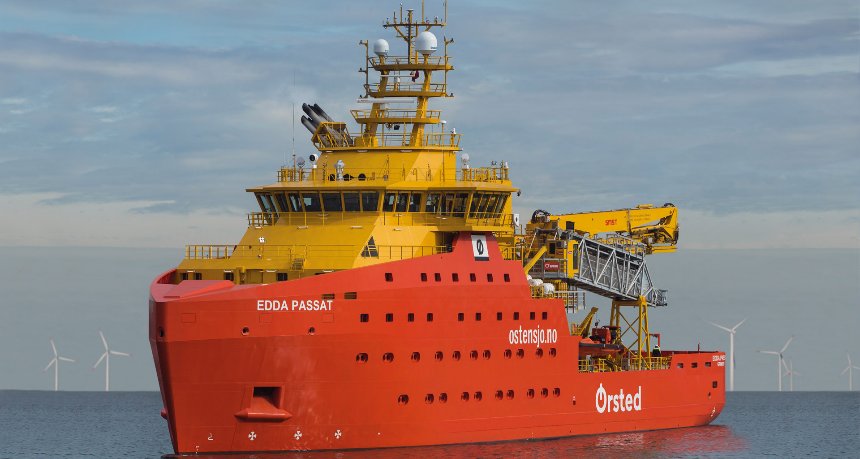
However, the deals in the sector show no sign of abating, even if they are starting to take the form of a snake chasing its own tail (known as an ouroboros) as companies buy and sell assets from each other.
Purus recently announced that it was buying the 2018-built service operation vessel (SOV) Edda Passat and would be renaming the vessel Purus Horizon and upgrading her to IMO Tier III status before the end of June to provide large NOx and SOx savings as well as hybridisation in the future. Last week, bunker supplier Monjasa’s C-BED walk-to-work subsidiary announced a contract win with struggling Siemens Gamesa for Wind Creation (the former VOS Stone), the second of the two SOVs it acquired in the great sell off of Vroon Offshore Services.
There are now dozens of new SOVs on order, mostly without charters. The specialist nature of the SOV requirements means that each costs around US$50 million or more, while the amount would be up to US$70 million for a commissioning SOV.
Cyan “maybe a little bit” Renewables?
However, the fact that the first US$1 billion fund raised by Cyan Renewables was mostly spent buying MMA Offshore for US$673 million. Now, MMA has some revenue from wind projects in Taiwan, but it is not exactly a pureplay renewables operator, and nor was Cyan’s previous acquisition of Aberdeen-based Sentinel Marine, a company focused on safety standby and fishery protection.
Cyan also bought one SOV from DEME to buy some track record in the sector, and ordered another at Vard in Vietnam against a 15-year contract in Taiwan, which many in the industry predict is a loss leader. It appears from page 218 of the DEME 2023 annual report that the SOV Groenewind may have cost Cyan around US$55 million, but this remains unconfirmed.
If Cyan cannot find worthwhile wind investments, and did not follow through on its WTIV newbuild plans in China, is this a sign that the returns in the sector will disappoint? We understand that Seraya Partners, the savvy investment bankers behind Cyan, are raising another US$1 billion renewables-focused fund from pension funds and sovereign wealth investors such as Singapore’s Temasek Holdings. Perhaps Cyan will finally order its WTIVs in its second wave.
Or perhaps the “Renewables” in its name will become silent, like the letter “b” in the words “dumb”, “debt,” and “tomb”?
What do you think? Email [email protected] with your prognostications for when and if the wind industry bust will occur.
Further reading
When we first reported on NEOM in 2020, we noted that it was a US$500 billion project. Now, Bloomberg reports a US$1.5 trillion figure. We are guessing the new plan takes the spending back to where the old plan was. Our 2023 piece entitled “Opec, Ronaldo and Neom: Oil, football and death sentences make a macabre combination” sets out the background to NEOM.


